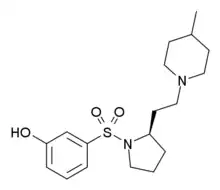 | |
| Identifiers | |
|---|---|
| |
| CAS Number | |
| PubChem CID | |
| IUPHAR/BPS | |
| ChemSpider | |
| ChEMBL | |
| CompTox Dashboard (EPA) | |
| Chemical and physical data | |
| Formula | C18H28N2O3S |
| Molar mass | 352.49 g·mol−1 |
| 3D model (JSmol) | |
| |
| |
| | |
SB-269970 is a drug and research chemical developed by GlaxoSmithKline used in scientific studies. It is believed to act as a selective 5-HT7 receptor antagonist (EC50 = 1.25 nM) (or possibly inverse agonist). A subsequent study in guinea pig at a concentration of 10 μM showed that it also blocks the α2-adrenergic receptor.[1][2][3] The large difference in test concentrations however confirms the selectivity of SB-269970 for the 5-HT7 receptor.
SB-269970 is used to study the 5-HT7 receptors which are thought to be involved in the function of several areas of the brain such as the hippocampus and thalamus,[4] and regulation of dopamine release in the ventral tegmental area.[5] Possible therapeutic uses for SB-269970 and other 5-HT7 antagonists include the treatment of anxiety and depression,[6][7] and nootropic effects have also been noted in animal studies.[8][9]
References
- ↑ Mahé C, Loetscher E, Feuerbach D, Müller W, Seiler MP, Schoeffter P (July 2004). "Differential inverse agonist efficacies of SB-258719, SB-258741 and SB-269970 at human recombinant serotonin 5-HT7 receptors". European Journal of Pharmacology. 495 (2–3): 97–102. doi:10.1016/j.ejphar.2004.05.033. PMID 15249157.
- ↑ Lovell PJ, Bromidge SM, Dabbs S, Duckworth DM, Forbes IT, Jennings AJ, et al. (February 2000). "A novel, potent, and selective 5-HT(7) antagonist: (R)-3-(2-(2-(4-methylpiperidin-1-yl)ethyl)pyrrolidine-1-sulfonyl) phen ol (SB-269970)". Journal of Medicinal Chemistry. 43 (3): 342–5. doi:10.1021/jm991151j. PMID 10669560.
- ↑ Foong JP, Bornstein JC (February 2009). "5-HT antagonists NAN-190 and SB 269970 block alpha2-adrenoceptors in the guinea pig". NeuroReport. 20 (3): 325–30. doi:10.1097/WNR.0b013e3283232caa. PMID 19190523. S2CID 25499247.
- ↑ Thomas DR, Hagan JJ (February 2004). "5-HT7 receptors". Current Drug Targets. CNS and Neurological Disorders. 3 (1): 81–90. doi:10.2174/1568007043482633. PMID 14965246.
- ↑ Mnie-Filali O, Dahan L, Zimmer L, Haddjeri N (September 2007). "Effects of the serotonin 5-HT(7) receptor antagonist SB-269970 on the inhibition of dopamine neuronal firing induced by amphetamine". European Journal of Pharmacology. 570 (1–3): 72–6. doi:10.1016/j.ejphar.2007.05.037. PMID 17586491.
- ↑ Hedlund PB, Huitron-Resendiz S, Henriksen SJ, Sutcliffe JG (November 2005). "5-HT7 receptor inhibition and inactivation induce antidepressantlike behavior and sleep pattern". Biological Psychiatry. 58 (10): 831–7. doi:10.1016/j.biopsych.2005.05.012. PMID 16018977. S2CID 10998014.
- ↑ Wesołowska A, Nikiforuk A, Stachowicz K, Tatarczyńska E (September 2006). "Effect of the selective 5-HT7 receptor antagonist SB 269970 in animal models of anxiety and depression". Neuropharmacology. 51 (3): 578–86. doi:10.1016/j.neuropharm.2006.04.017. PMID 16828124. S2CID 39928418.
- ↑ Gasbarri A, Cifariello A, Pompili A, Meneses A (December 2008). "Effect of 5-HT(7) antagonist SB-269970 in the modulation of working and reference memory in the rat". Behavioural Brain Research. 195 (1): 164–70. doi:10.1016/j.bbr.2007.12.020. PMID 18308404. S2CID 12910296.
- ↑ Liy-Salmeron G, Meneses A (2008). "Effects of 5-HT drugs in prefrontal cortex during memory formation and the ketamine amnesia-model". Hippocampus. 18 (9): 965–74. doi:10.1002/hipo.20459. PMID 18570192. S2CID 20937527.